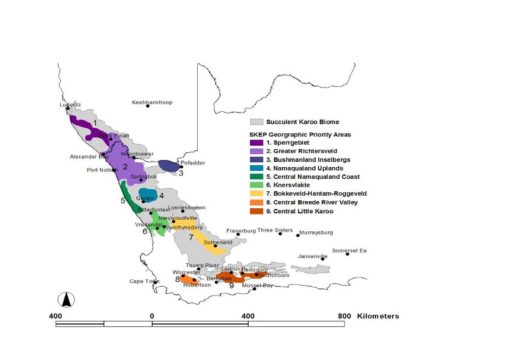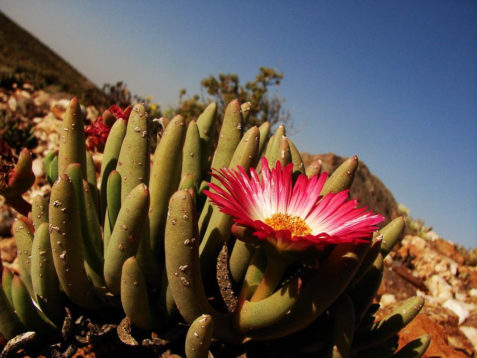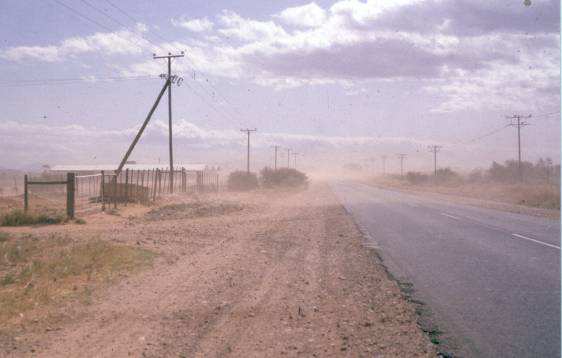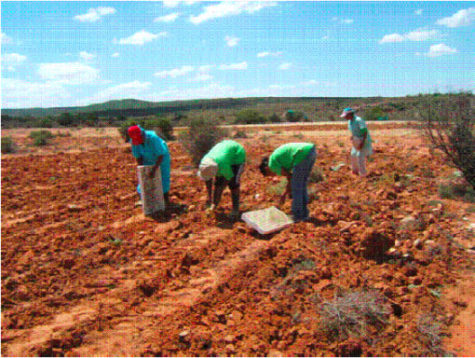Overview
Stretching along the Atlantic coast of Africa, from southwestern South Africa into southern Namibia, the Succulent Karoo biodiversity hotspot covers 102,691 square kilometers of desert. It is one of the 34 richest and most threatened reservoirs of plant and animal life on Earth. These biodiversity hotspots cover only 2.3 percent of the planet, yet contain 77 percent of all terrestrial species diversity.
The Succulent Karoo Ecosystem Programme (SKEP) is the result of a one-year planning process which combined a rigorous scientific process with broad land-user participation to identify and generate broad consensus around an ultimate vision and set of conservation targets for the Succulent Karoo. This process was initiated in September 2001 and completed one year later. It was facilitated by Conservation International’s (CI) Southern Africa Hotspots Program and formed part of the Critical Ecosystem Partnership Fund’s (CEPF) preparation to expand its investment to the hotspot. The Succulent Karoo hotspot is an appropriate recipient of CEPF investment for several reasons. The region’s levels of plant diversity and endemism rival those of rain forests, making the Succulent Karoo an extraordinary exception to the low diversity typical of arid areas and the only arid ecosystem to be recognized as a global biodiversity hotspot. Nearly one-third of the floral species of the region are unique to the hotspot and the region boasts the richest variety of succulent flora in the world (just under one-third of the Succulent Karoo’s flora are succulents). In addition to its floral diversity, the hotspot is a center of diversity for reptiles and many groups of invertebrates.
The Succulent Karoo is under extreme pressure from human activities, including overgrazing, mining, illegal collection of wild plants and animals and the impact of climate change. However, there are many opportunities for conserving the hotspot’s remarkable biodiversity due to the low human population density, large areas of extant (albeit severely grazed in places) habitat, low costs of conservation in most of the region and good opportunities for biodiversity-friendly forms of land use in many areas.
Six strategic directions guide CEPF’s approach in the Succulent Karoo:
1. Expand protected area corridors through public-private-communal partnerships in the priority areas of Bushmanland Inselbergs, Central Namaqualand Coast, Namaqualand Uplands, Knersvlakte, Hantam-Roggeveld, Central Little Karoo, and Sperrgebiet
2. Engage key industrial sectors in meeting conservation objectives identified by SKEP
3. Retain and restore critical biodiversity in areas under greatest land-use pressure
4. Mainstream conservation priorities into land-use planning and policymaking
5. Increase awareness of the Succulent Karoo Hotspot
6. Create the capacity to catalyze the SKEP program
Quick Facts
Project Location:
-32.4100977, 20.670528
Geographic Region:
Africa
Country or Territory:
Namibia, South Africa
Biome:
Desert/Arid Land
Ecosystem:
Other/Mixed
Area being restored:
~100,000 Square Kilometers
Project Lead:
The Succulent Karoo Ecosystem Programme
Organization Type:
NGO / Nonprofit Organization
Project Partners:
Conservation International's Southern Africa Hotspots Program, the Critical Ecosystem Partnership Fund's
Location
Project Stage:
Implementation
Start Date:
2001-01-21
End Date:
2008-01-21
Primary Causes of Degradation
Agriculture & Livestock, Mining & Resource ExtractionDegradation Description
The hotspot is vulnerable to several land use pressures, particularly overgrazing on communal lands, ostrich farming in the southeast, mining and the illegal collection of plants and animals for trade. Anthropogenic climate change is predicted to have a serious impact on the region’s biodiversity.
Agriculture: The most extensive pressure on biodiversity in the Succulent Karoo is livestock grazing. Goat, sheep, ostrich and small game ranching are the dominant land uses in approximately 90 percent of the hotspot and although stock limits and grazing plans exist for much of the hotspot, signs of overgrazing are evident over much of the landscape. This is particularly true in communal lands where motives for maintaining livestock numbers that exceed the capacity are not simply profit driven and where limited incentives and economic alternatives exist. Ostrich grazing, unlike small livestock grazing, tremendously impacts veld by selective grazing of high protein plants and seeds and compacting soil, effectively creating dust bowls.
Mining: The entire northern extension of the Succulent Karoo is mineral rich and with various mining applications pending throughout the region, transformation from mining operations represents a significant pressure. Open caste and alluvial mining activities for diamonds along the coast and river flood plains have nearly transformed the entire coastline. New markets and discoveries of base metals such as zinc and copper as well as gypsum and quartz deposits continue to transform large areas of limited habitat types. In addition to large corporations, uncontrolled prospecting by smaller companies and individuals is encroaching on the fragment patches of dune and coastal shrubland.
Other direct pressures: In addition to these indiscriminate pressures, collection of rare and commercially valuable species is a pressure as is an increase of unregulated tourism activities in many fragile ecosystems. Thus, although the increase in tourism to the region could certainly help create an opportunity for biodiversity conservation, it is currently having a negative impact on numerous species.
Reference Ecosystem Description
The rich biodiversity of the Succulent Karoo hotspot is due to an extensive and complex array of habitat types derived from topographical and climatic diversity in the region’s rugged mountains, semi-arid shrublands and coastal dunes. The hallmark of the hotspot is its exceptionally diverse and unique flora, especially succulents and bulbs. Many species are extreme habitat specialists, mainly related to soil type and of limited range size. Local endemism (i.e. the restriction of species to extremely small ranges of <50 km2) is most pronounced among bulbs and Mesembryanthemaceae and other succulents. Similar patterns of compositional change along gradients have been observed for certain groups of invertebrates. In addition to invertebrates, faunal diversity and endemism is high for reptiles, amphibians and some mammals.
Project Goals
The overarching vision of SKEP is that “The people of the Succulent Karoo take ownership of and enjoy their unique living landscape in a way that maintains biodiversity and improves livelihoods now and into perpetuity.”
The specific 20-year conservation targets that have been identified thus far for the Succulent Karoo are:
1. 75 percent of the conservation targets set in the SKEP process for 135 vegetation types will be protected and conserved.
2. Key climatic gradients and riverine corridors are taken into consideration in the creation or expansion of any protected areas.
3. Globally threatened and endangered species listed in the Red Data sources will be under additional protection.
4. Sites in the Succulent Karoo hotspot that house unique, endemic and globally threatened species will be identified and protected.
Monitoring
The project does not have a monitoring plan.
Stakeholders
The Critical Ecosystem Partnership Fund (CEPF) is designed to safeguard the world’s threatened biodiversity hotspots in developing countries. It is a joint initiative of Conservation International (CI), the Global Environment Facility (GEF), the Government of Japan, the MacArthur Foundation and the World Bank. CEPF supports projects in hotspots, areas with more than 60 percent of the Earth’s terrestrial species in just 1.4 percent of its land surface. A fundamental purpose of CEPF is to ensure that civil society is engaged in efforts to conserve biodiversity in the hotspots. An additional purpose is to ensure that those efforts complement existing strategies and frameworks established by local, regional and national governments.
The SKEP process involved more than 60 scientific experts and over 400 local stakeholders representing government, academia, nongovernmental organizations, private sector interests, and local communities. SKEP developed an overarching framework for biodiversity conservation and sustainable development in the hotspot.
Description of Project Activities:
Nearly 90 individual projects, carried out by a variety of implementing agencies, have been initiated since the completion of the SKEP process in 2002. A list and description of each individual project can be found at http://www.skep.org/projects.php. Although varying widely in specific purpose and geographical focus, each project is included in one of the six CEPF strategic funding directions:
1. Expand protected area corridors through public-private-communal partnerships in specific geographic priorities
This funding direction is aimed at undertaking specific catalytic activities that will assist in the expansion of the Succulent Karoo hotspot's protected area system through the establishment of five large conservation corridors (or megareserves). When implemented, these corridors should be sufficiently large to achieve conservation targets for numerous Red List species and many vegetation types. In addition, they should be able to accommodate a wide range of processes, including large mammal migration routes, riverine corridors and climatic gradients. The incorporation of the last-mentioned feature should provide resilience to climate change.
A major obstacle to implementing projects of this scale is a lack of capacity among conservation agencies. Consequently, CEPF's niche within the larger objective is to establish project management teams which can catalyze planning and specific implementation of key activities that will build the momentum required to eventually establish five large conservation corridors. These teams, appointed under the auspices of an appropriate nongovernmental organization, should work in close partnership with the appropriate conservation agency and provide mentorship for officials of the agency that will ultimately inherit the project. These teams that will include individuals with project management, community extension, and conservation planning expertise will develop strategies for creating new protected areas that enjoy support and generate benefits for a broad range of stakeholders. These teams, will be responsible for securing local stakeholder participation, necessary political buy-in, consolidating baseline information on biodiversity for long-term monitoring, developing management plans that formalize roles of each partner, and creating strategies for long-term financial sustainability. Such a model is being piloted for the Baviaanskloof megareserve in the Cape Floristic Region, where the provincial conservation agency has provided substantive co-funding.
Wherever possible, these projects should build on and be integrated with existing projects in and around the respective priority areas. For example, the potential synergies between the Cederberg and Gouritz megareserves (being implemented as part of the Cape Action Plan for the Environment) and the Hantam-Roggeveld and Central Little Karoo megareserves, respectively, should be expanded.
2. Engage key industrial sectors in meeting conservation objectives identified by SKEP
Many potential partnerships exist between the conservation community and key industrial sectors in the Succulent Karoo hotspot that could lead to positive conservation outcomes. This funding direction will target these sectors by building relationships with key stakeholders and exposing them to opportunities for enhancing their business interests while simultaneously meeting conservation objectives. These include industries based on resources that constitute high opportunity costs for conservation (e.g. mining, ostrich ranching) as well as those whose objectives are potentially aligned with conservation (e.g. ecotourism, wildlife ranching).
3. Retain and restore critical biodiversity in areas under greatest land use pressure
The achievement of conservation targets in landscapes subject to severe land use pressures, where extant habitat is often fragmented, is a huge challenge for conservation. This funding direction will address this challenge through the identification of spatial priorities at the fine-scale (1:10,000 - 1:50,000) and the investigation of mechanisms to create small reserves and reduce pressures on the unreserved remnants.
4. Mainstream conservation planning outcomes in land-use planning and decision-making
In both Namibia and South Africa, decisions regarding land use have been devolved to local or district municipalities. These municipalities are legally bound to prepare spatial plans and associated development priorities for investment every five years. Local government legislation requires these plans to incorporate biodiversity concerns. This legislation provides an excellent opportunity to mainstream biodiversity concerns into land use planning and practice. Unfortunately, most local government agencies in the Succulent Karoo hotspot do not have the capacity to produce the appropriate information on biodiversity as well as the ability to use such information, even if it were provided. This strategic funding direction is aimed at providing the appropriate biodiversity products for municipal-level planning and increasing the capacity of officials to use these products. The associated projects should draw on the experience gained from similar exercises in the Cape Floristic Region and the Subtropical Ecosystem Planning Project planning domain. The intention should be to build core capacity for generating and updating products, and for providing training within the provincial conservation agency of the Northern Cape as well as within the Conservation Planning Unit of the Western Cape Nature Conservation Board.
5. Increase awareness of the Succulent Karoo hotspot
Unlike the adjacent Cape Floristic Region hotspot, where the "fynbos" and "Cape Floral Kingdom" names are widely known, awareness of the Succulent Karoo's unique biodiversity status is relatively poorly developed at the local, regional and national levels. This funding direction will meet the urgent need to promote awareness of the hotspot from local to national scales, through support to projects such as a well-coordinated binational awareness campaign. Within this strategic direction, CEPF will also support efforts to publicize the biological importance of the Succulent Karoo hotspot and educate stakeholders about threatened and unique species from the Succulent Karoo as flagship species.
6. Create capacity to catalyze the SKEP program
Effective identification and implementation of projects consistent with CEPF investment priorities and the larger 20-year SKEP vision will require a proactive approach to catalyzing targeted activities that will build the momentum required to conserve the Succulent Karoo hotspot. These include the establishment of a small grants fund and a network of champions to identify, mentor and monitor small-scale projects, which can be undertaken at a local scale and involve largely, but not exclusively, disadvantaged communities. Champion teams may also become involved in larger projects occurring within their subregions and will hopefully participate in or influence local government deliberations that deal with biodiversity concerns.
This funding direction will also establish a coordination unit for implementing SKEP, including the CEPF investment priorities identified above. As per agreed policy, this unit will be incorporated into the Bioregional Planning Unit of South Africa's National Botanical Institute (soon to become the National Biodiversity Institute).
Ecological Outcomes Achieved
Eliminate existing threats to the ecosystem:
Approximately 60 individual projects in the Succulent Karoo ecoregion, focusing on 9 geographical priority areas, have been completed since the SKEP process was completed in 2002. These projects address a wide range of goals and strategies outlined by SKEP.
Factors limiting recovery of the ecosystem:
Despite the documented diversity of the hotspot, global and local awareness of the significance and value of the Succulent Karoo is scant. While funding to secure land has made substantial progress, lack of funding to develop and manage these resources has resulted in a situation where the parks are largely protected only on paper. Grazing, collection of wildlife for trade and mining and prospecting continue unabated in some areas.
The complex sociopolitical environment also impacts the levels of protection for biodiversity in the hotspot. Two countries, three provincial/regional governments and more than 50 local government bodies are located within the hotspot. Decentralization of many of the administrative functions of the South African and Nambian governments to the provincial (regional in Namibia) and municipal levels has led to the expansion of the role of local government in conservation and land-use issues. Building the capacity of staff in local government to integrate biodiversity concerns into their planning and regulatory practices is an important opportunity for civil society to participate in and influence long-term planning for conservation.
Socio-Economic & Community Outcomes Achieved
Economic vitality and local livelihoods:
Available socioeconomic data indicate that CEPF-supported projects in the Succulent Karoo of South Africa and Namibia often occur in rural areas with a high level of poverty. Within these areas of poverty, CEPF grantees tend to focus largely on poorer households that are indigenous, have little or no land, or depend directly on wild resources as subsistence hunter-gatherers. CEPF projects directly and indirectly contribute to poverty reduction and improve human conditions in these regions while achieving their primary objective of biodiversity conservation. Direct impacts include creating jobs and providing training to local peoples. Indirect impacts include creating local organizations, strengthening civil societies, and other activities that maintain and restore the ecosystems upon which many poor people in the Succulent Karoo rely.
Key Lessons Learned
The Succulent Karoo is one of the biological wonders of the world, with unrivaled levels of diversity and endemism for an arid area. The increasing threats to this unique region have compelled significant global, national and local commitment to a comprehensive plan for its conservation: the Succulent Karoo Ecosystem Plan. CEPF provides a source of funding in the Succulent Karoo designed to reach NGOs in a way that complements funding for government agencies and other stakeholders; supports the framework established by SKEP; ensures that civil society has an opportunity to contribute to conservation; and provides a flexible, responsive funding mechanism for innovative conservation activities. By aligning its focus with the conservation and sustainable development goals of SKEP, CEPF will augment efforts to address immediate threats and contribute to long-term conservation in the hotspot, developing a model of sustainable regional conservation efforts that could be replicated in other arid regions facing similar pressures and in other biodiversity hotspots around the world.
The momentum generated by the stakeholder process for developing this profile and existing capacity in the region provides an opportunity for CEPF to support priority actions within the SKEP framework that will secure areas for conservation, build the capacity for a programmatic approach and conserve the Succulent Karoo’s biodiversity in perpetuity.
Long-Term Management
The CEPF monitoring approach focuses on monitoring and evaluating performance and impact of the overall program, as well at the ecosystem and individual project levels. The three levels will be carefully integrated to build linkages between the program’s overall purpose, the strategic directions and investment priorities identified to achieve selected conservation targets in the many projects that CEPF supports.
The SKEP 20-year strategy is derived directly from the people living in the Succulent Karoo, and confirmed and augmented by the scientific community, national and regional-level stakeholders through the SKEP process. The strategy consists of a comprehensive set of actions that will achieve conservation targets by addressing constraints and maximizing opportunities that are most relevant for each sub-region. These actions are summarized as a series of four strategic focal areas:
1. Increasing awarenessӬ
2. Expanding Protected AreasӬ
3. Harmonious Land UsesӬ
4. Institutional Coordination.
Though far-reaching and widely supported, it is recognized that SKEP is a living strategy and these priority actions and strategic emphases will evolve over time.
Sources and Amounts of Funding
11,241,000 USD Donors and funding agencies for SKEP include CEPF ($8 million), Development Bank of South Africa”¨, Conservation International”¨, Mulago Foundation”¨, European Union”¨, British High Commission”¨, Namibian Nature Foundation Environment Fund, Global Conservation Fund”¨, South African Biodiversity Institute”¨, Global Environment Facility (Sperrgebiet)”¨, Leslie Hill Succulent Trust / WWF”¨, Botanical Society of South Africa (Eco schools node), “¨Nedbank Go Green Fund Namibia, “¨Ministry of Environment and Tourism (Namibia)”¨, and Global Environment Facility (UNDP).
Financial and logistical support for each of the individual projects are provided by these and other agencies and organizations.
Other Resources
Cindy Mathys
ҬSKEP Communications OfficerӬ
South African National Biodiversity Institute (SANBI)Ӭ
Private Bag X7″¨
ClaremontӬ
7735″¨
(tel)Â +27 21 799 8854″¨
(fax) +27 21 797 1940
[email protected]
Publications:
Peer Reviewed:
Beukes, P. C. and R. M. Cowling (2003). “Evaluation of Restoration Techniques for the Succulent Karoo, South Africa.” Restoration Ecology 11(3): 308-316.
Not Peer Reviewed:
http://www.skep.org/
http://www.cepf.net/xp/cepf/where_we_work/succulent_karoo/succulent_karoo_info.xml
http://www.worldwildlife.org/wildworld/profiles/terrestrial/at/at1322_full.html
Project completion documents for individual projects: http://www.cepf.net/xp/cepf/resources/publications/final_reports_regional.xml?region=Succulent+Karoo
Detailed list of all individual projects under SKEP: http://www.skep.org/projects.php





